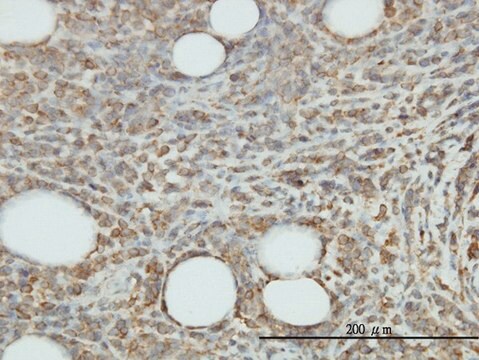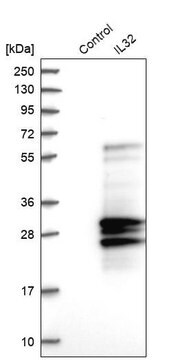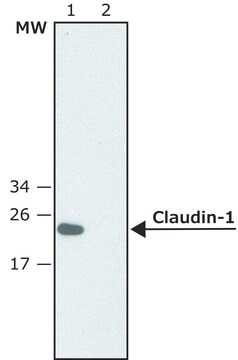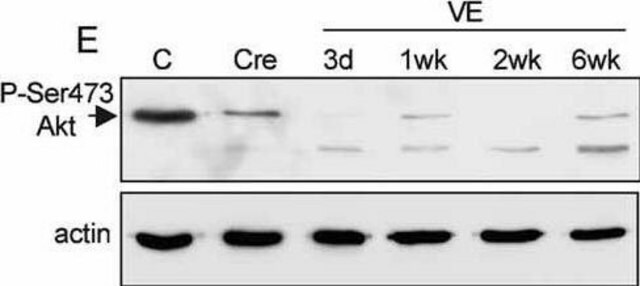詳細
We are committed to bringing you greener alternative products, which adhere to one or more of The 12 Principles of Green Chemistry.This antibody is Preservative-free, produced without the harm or sacrifice of animals and exceptionally stable to allow for ambient shipping and storage if needed and thus aligns with "Waste Prevention", "Designing Safer Chemicals" and "Design for Energy Efficiency".
Click here for more information.
ZooMAb® antibodies represent an entirely new generation of recombinant monoclonal antibodies.Each ZooMAb® antibody is manufactured using our proprietary recombinant expression system, purified to homogeneity, and precisely dispensed to produce robust and highly reproducible lot-to-lot consistency. Only top-performing clones are released for use by researchers. Each antibody is validated for high specificity and affinity across multiple applications, including its most commonly used application. ZooMAb® antibodies are reliably available and ready to ship when you need them.
特異性
Clone 2L6 is a ZooMAb® Rabbit recombinant monoclonal antibody that specifically detects Interferon regulatory factor 1 (IRF-1). It targets and epitope within 16 amino acids from the N-terminal half.
免疫原
KLH-conjugated linear peptide corresponding to 16 amino acids from the N-terminal half of human Interferon regulatory factor 1 (IRF-1).
アプリケーション
Quality Control Testing
Evaluated by Western Blotting in lysates from serum starved HeLa cells treated with interferon .
Western Blotting Analysis (WB): A 1:1,000 dilution of this antibody detected IRF-1 in lysates from overnight serum starved HeLa cells treated with interferon (100 ng/mL; 24 h).
Tested applications
Immunohistochemistry (Paraffin) Analysis: A 1:100 dilution from a representative lot detected IRF-1 in human small intestine tissue sections.
Immunocytochemistry Analysis: A 1:100 dilution from a representative lot detected IRF-1 in HeLa cells treated with interferon (100 ng/mL; 24 h).
Flow Cytometry Analysis: 0.1 μg from a representative lot detected IRF-1 in one million HeLa cells.
Affinity Binding Assay: A representative lot of this antibody bound IRF-1 peptide with a KD of 5.0 x 10-7 in an affinity binding assay.
Note: Actual optimal working dilutions must be determined by end user as specimens, and experimental conditions may vary with the end user
Evaluated by Western Blotting in lysates from serum starved HeLa cells treated with interferon .
Western Blotting Analysis (WB): A 1:1,000 dilution of this antibody detected IRF-1 in lysates from overnight serum starved HeLa cells treated with interferon (100 ng/mL; 24 h).
ターゲットの説明
Interferon regulatory factor 1 (UniProt: P10914; also known as IRF-1) is encoded by the IRF1 gene (Gene ID: 3659) in human. IRF-1 is a transcriptional regulator that is expressed constitutively in all cell types except in early embryonal cells. It can exist as a monomer and as a homodimer and displays remarkable functional diversity in the regulation of cellular responses, including the regulation of interferon (IFN) and IFN-inducible genes and host response to viral and bacterial infections. It also regulates many genes expressed during hematopoiesis, inflammation, immune responses, cell proliferation and differentiation, and growth arrest and apoptotic cell death following DNA damage. It is reported to act as a tumor suppressor and plays a role blocking tumor cell growth and stimulating an immune response against tumor cells. It is known to represses genes involved in anti-proliferative response, such as survivin, cyclin B1, cyclin E1, Cdk1, Cdk2, Cdk4 and in immune response, such as FOXP3, IL-4, and TLR4. IRF-1 is reported to stimulate p53/TP53-dependent transcription through enhanced recruitment of EP300 leading to increased acetylation of p53/TP53. Its DNA-binging domains are located in the first 115 amino acids of N-terminal region and contains a series of five well-conserved tryptophan-rich repeats. IRF-1 can be phosphorylated by casein kinase 2, which positively regulates its activity. Mutations in IRF1 gene have been linked to increased susceptibility to gastric cancer that can spread to esophagus and small intestine. This ZooMAbZooMAb® recombinant monoclonal antibody, generated by our propriety technology, offers significantly enhanced specificity, affinity, reproducibility, and stability over conventional monoclonals. (Ref.: Dou, L., et al. (2014). Hum. Immunol. 75(11); 1110-1114; Savistsky, D., et al. (2010). Cancer Immunol. Immunother. 59(4); 489-510; Bowie, ML., et al. (2008). Adv. Exp. Med. Biol. 617; 367-374).
物理的形状
Purified recombinant rabbit monoclonal antibody IgG, lyophilized in PBS, 5% Trehalose, normal appearance a coarse or translucent resin. The PBS/trehalose components in the ZooMAb formulation can have the appearance of a semi-solid (bead like gel) after lyophilization. This is a normal phenomenon. Please follow the recommended reconstitution procedure in the data sheet to dissolve the semi-solid, bead-like, gel-appearing material. The resulting antibody solution is completely stable and functional as proven by full functional testing. Contains no biocide or preservatives, such as azide, or any animal by-products. Larger pack sizes provided as multiples of 25 μL.
保管および安定性
Recommend storage of lyophilized product at 2-8°C; Before reconstitution, micro-centrifuge vials briefly to spin down material to bottom of the vial; Reconstitute each vial by adding 25 μL of filtered lab grade water or PBS; Reconstituted antibodies can be stored at 2-8°C, or -20°C for long term storage. Avoid repeated freeze-thaws.
法的情報
ZooMAb is a registered trademark of Merck KGaA, Darmstadt, Germany
免責事項
Unless otherwise stated in our catalog or other company documentation accompanying the product(s), our products are intended for research use only and are not to be used for any other purpose, which includes but is not limited to, unauthorized commercial uses, in vitro diagnostic uses, ex vivo or in vivo therapeutic uses or any type of consumption or application to humans or animals.










